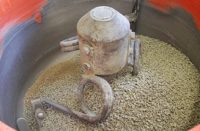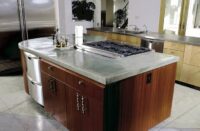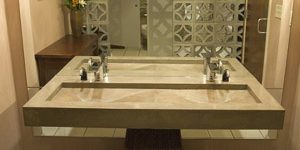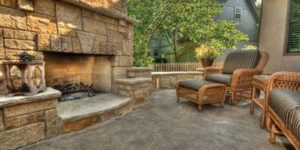Jimmy Hazel began his career working in the family stone business, but quickly tired of the monotony once he discovered decorative concrete’s variety. “My father’s been in the stone industry for 20+ years and after working there for a little while I just really wasn’t into working with tile or granite,” Hazel says.
“You are already given the slabs and then all you really had to do was cut them and polish the edges, where concrete offers so much versatility and being able to design a product. You’re really making something from nothing, which is interesting to me.”
Hazel joined the family business in 2008. Back then, he raced motorcycles professionally, but decided it was time to get a “real job.” He worked under his father for a few months and then branched off to get his own contractor’s license.
 |
 |
 |
“I just had to find something else,” he says. “I got started because I looked in a magazine — it was probably Concrete Decor — and I saw it and said, ‘Hey, why don’t we try this?’ and it kind of snowballed from there.”
The trial-and-error method
He chose the name Clastic Designs thinking that there was already a glut of businesses with concrete in the name. “Clastic is a type of rock that’s actually derived from bits and pieces of older rock and in a way that’s kind of what we do,” he says. “We have aggregate and all these other refined materials that are used to create this new rock.”
He didn’t take a lot of training courses, instead teaching himself from trial and error. “Some people are blessed with an understanding of how concrete chemistry works but for me it was more coming from, ‘what should it look like installed?’ For us the learning curve of the chemistry of concrete was quite a struggle. The first time we put in a superplasticizer it blew my mind in the way it altered the chemistry and the matrix of concrete, which is a simple powder.”
His first kitchen, installed in 2008, had to be redone four times. Luckily the client was understanding, but Hazel recalls that it was challenging to go from a sample to an actual large kitchen and make it look like it was supposed to.
Precast takes precedence
In the years since, Hazel has become an expert in everything precast. “We do a lot of fireplaces, kitchens, bathrooms,” he says. “Really anything you could think of.”
Hazel and his crew of five have the most fun with large-scale projects such as focal-point fireplaces. Thanks to his granite background, he has a rich understanding of how things are fabricated. That enters into his concrete work in the sense that he will create things that most concrete contractors typically don’t do, such as board-forming and mitering the corners on his concrete.
 |
“One board-form fireplace that we did was really neat because we matched the grain coming from the sides and along the front and then back to the side where some guys might make that a 3-D panel,” he says. “We mitered the corners because it was such a large scale that if we were putting panels up we didn’t think we would be able to lift them in once we got to the top.”
While Clastic has created many kitchen and bath countertops and sinks, it’s the concrete fireplaces Hazel enjoys the most. “Fireplaces are the centerpieces of the whole room and to me fireplaces really showcase the unique abilities of concrete,” he says.
“Also fireplaces are neat in that we can do these really large-scale 3-D objects that accentuate the concrete’s unique value. And unlike working with stone, there’s so much involved in the processes of concrete from start to ending and you have to be so meticulous along the way.”
Another favorite fireplace project was one with two 20-foot-tall black columns on either side of a large hearth. The columns were so heavy it took 10 guys on scaffolding who lifted them straight up into the air. “We do a lot of pretty complex installations,” Hazel says.
“We really emphasize what the final project is going to be like. Instead of making something and putting it in and saying, ‘That’s just as good as it’s going to get,’ we strive to figure out how we can make it better and make it look better.”
 Business is growing
Business is growing
Hazel both designs projects for his clients and also works with their designers and architects. He says his clients often come to him with an idea and he collaborates with them and their other contractors to bring the project to life.
Clastic is located in Sparks, Nevada, east of Reno. Hazel is only 29, but has honed his craft continuously since getting started. He’s also been privileged to work in some large, elite developments being built near Lake Tahoe. He’s developed close relationships with architects and designers in that area who are familiar with his portfolio and are appreciative of what concrete can do.
Hazel says he is starting to branch out into the San Francisco Bay area, which he’s excited about. One current job in Kingman, Arizona, involves replicating an old mineshaft. “We get to do an Old World play on concrete for this job,” says Hazel. “There are a lot of neat finishes that play into that.”
 Hazel and his wife, Ryann, who manages the back-end of the business, also have three young children. It’s a crazy household, he admits, but he and his family find the passion in everything they take on.
Hazel and his wife, Ryann, who manages the back-end of the business, also have three young children. It’s a crazy household, he admits, but he and his family find the passion in everything they take on.
“Every project has its high moments that I really enjoy,” he says. “We just keep going. We learn how to make one thing and then keep learning how to make different things and larger things and more unique 3-D things. It’s a never-ending process of self-discovery and growth.”
www.clasticdesigns.com


























